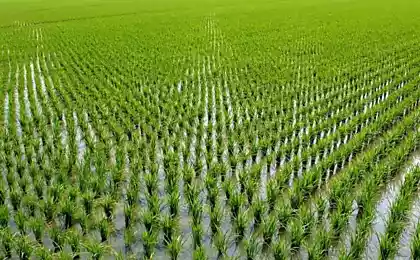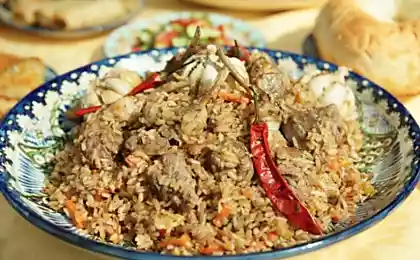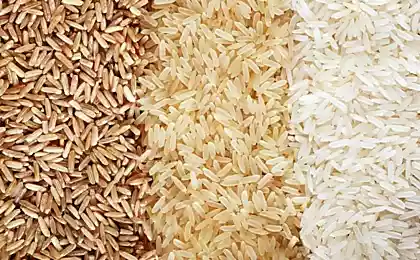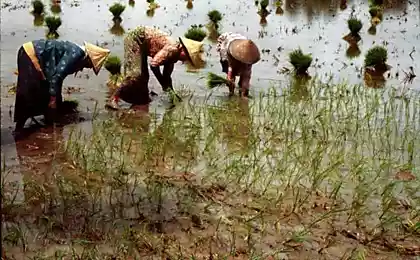1829
Rice, and rice
Eat rice - so eat right. "Whoever offers rice, offers life itself" Buddha said, recognizing the nutritional properties of rice, as recognized and many other ancient cultures. Hippocrates made the ancient Olympians eat rice before and after the event, preparing for their mixture eptasanei, consisting of various cereals, water and honey. This is not far removed from what modern eat athletes preparing for competitions.
The word "rice" is the basis of Indo-Iranian. Modern pronunciation comes from the Greek oryza, which has undergone modifications Latin oriza (riso).
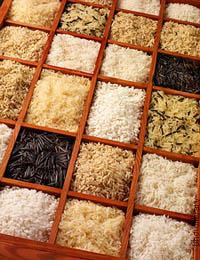
The history of rice
Man grows rice for thousands of years and the grass is rightly called the most popular around the world. His homeland is considered the north of modern Thailand and Vietnam, this is where people first began to cultivate rice. This plant was delicious and gave a bountiful harvest compared with millet and wheat.
Around 2,500 years ago, the father of history, Herodotus wrote about rice, boldly claiming that people in India uses rice in food, as millet. A few centuries later, during the reign of Nero (1900 years ago), the other, already a Roman historian, Dioskuridus, mentioned the figure in its annals, describing it as a multi-purpose product. In particular, he carefully described all sorts of dishes that can be prepared from rice, as well as an important element for women's cosmetics and as a remedy for food poisoning.
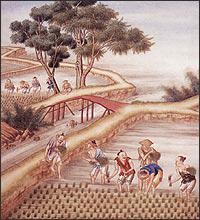
If the descendants of the first farmers to cultivate modest rice fields in northern Thailand in 4000 BC, survived to the present day, they would have told the youth of today are highly instructive stories about the ancient empire, who built his fortune solely on the export of rice. By 500 BC the secret weapon of Thais has been disclosed, and began to cultivate rice in India, China, Indonesia and Malaysia.
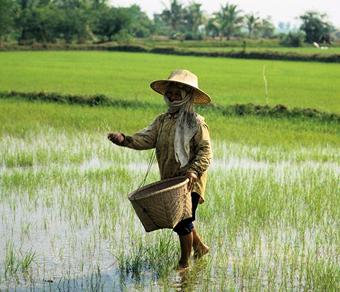
Moving further north, rice changed: in South Asia rice demanded a lot of water and warm all year round, in central China, Korea and Japan have taken root varieties that are transferred and the cold night air, and a relatively small amount of water. In Korea and Japan grew particularly well round grain rice, adherent during cooking and at the foot of the Himalayas in the Indian province of Punjab and Pakistan - fragrant long "Basmati". From China to Japan, including India and Indonesia, rice - it's more than just products. It's part of the culture and civilization in these countries.
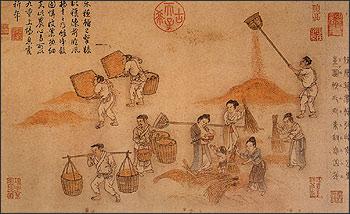
Vietnamese word «com» has two meanings: "cooked rice" and "food».
There is a legend, why the New Year in Vietnam cooked rice cakes and other rice dishes. Once upon a time there lived a king. He was old, and he knew that he left to live is not much. He had three sons, all of them were educated, strong and beautiful. King did not know whom to leave his successor, since all were worthy of it. Then he came up with such a thing.
New Year is approaching, and the king ordered his sons to make a treat for the whole country. The eldest son was able to prepare the dish only for the royal family, the middle - to the nation's capital. And the youngest son, realizing that only rice in the country is enough to feed all the people napek huge amount of rice cakes. Cakes enough for all, and the youngest son became heir to the King. Since then, Vietnam New Year always prepare rice cakes and other goodies from rice.
The Chinese word for agriculture in general, spelled and pronounced the same as the word for rice cultivation with the cultivation of seedlings, transplanting and its constant irrigation by flooding. The expression "break a bowl of rice" means to leave work.
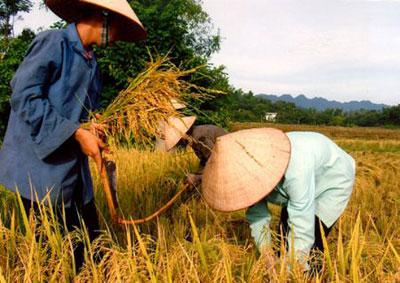
In Japan, rice was brought settlers from the Korean Peninsula roughly in the III century BC. By this time, living on the territory of the Japanese archipelago population ate almost all stocks of game and began to slowly die out. And who knows what would have ended the story, if not the rice, which has improved the situation as nutrition and demography.
Soon this became the basis of cereal Japanese welfare state. They collect taxes, and they also paid a salary to officials. The richness of the princes and their authority determined by how much rice they received in their possessions. Collecting dues from the peasants this cereal, Japanese feudal lords sent it up for sale. The most famous rice market was in Osaka. In the XVIII and XIX centuries there annually sold more than four million bags of cereal. As prices on the Osaka Securities Exchange determines the cost of rice across the country, in Japan introduced a system of signal fires, located on the mountain tops. Depending on the wood smoke and herbal supplements get different colors. This was the designation of the price that give today for rice in Osaka.
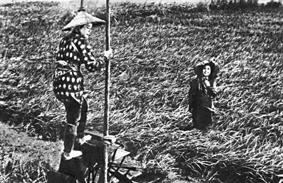
It is difficult to overestimate the role of rice in Japanese culture. It is a symbol of the state and the soul of the nation. When the previous Emperor Hirohito feel it does not matter, he nevertheless felt obliged to ask the cereal harvest. And the current monarch every spring transplant rice seedlings on his imperial box, and it is considered an important event, which cover almost all the newspapers and television channels. And all because of centuries of Japanese people had a steady view of the world - if the rice spike, consequently, the rest all is well. That is why during the World War II Japanese soldiers in memory of the homeland handed boxes filled with this cereal with red plum in the middle.
And rice - is an integral part of religious ritual. For example, he is the main offering to the souls of the dead. In the transfer of authority from the family-in-law to daughter-in occurs only when it gives Shamoji - spatula for laying rice. One of the main deities worshiped by the Japanese who still is the spirit of the rice field Hatake but kamisama. In ancient times, during the rite of rice planting one of the girls buried alive, to propitiate the gods of rice fields. Over time, the rite was, fortunately, modified, but some of its elements have been preserved to this day. Girls, plant rice seedlings in the field, coated with mud person or hem of her dress. This want to emphasize their magical connection with the deities of rice fields. After this ceremony all its participants become "brides", "women" or "children" rice deities.
By the way, popular in the archipelago sumo wrestling is nothing but a ritual dedicated to this spirit. It was believed that the more tread on the ground, the higher the yield of rice it will.
There is a Japanese legend about a landowner who lived in the times of the ancient empire. One man had a great harvest. And he decided to have some fun with joy, made from rice cake and began to shoot her with a bow as a target. Rice cakes suddenly turned into a white bird and flew away. And this entertainer never appeared on the rice fields ...
Few people know that the name of Honda means "main rice field." Rather, in the western world rice brought Alexander the Great after the conquest of India in 350 g BC. It is believed that the rice was one of the products that are traded in the markets of spices in Alexandria, although it was significantly cheaper than pepper.
In Europe, the first to be treated as an exotic seasoning: afford a rice dish, brought from distant Asia, could only honorable gentleman. Rice used in the preparation of desserts and sweets for holiday treats.
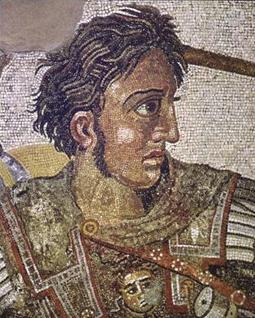
However, after the plague epidemic in the thirteenth century, in Southern Europe desperately lacked the manpower and food for commoners. Cultivation of wheat was too time-consuming process for flagging thinned and people. Came to the aid rice, which sowed the fields of Sicily and Valencia. Rice has taken root in Italy and Spain, and was mostly round-srednezernym. He did not require large amounts of water for irrigation and bring a good harvest.
In 1300, the figure was first mentioned in the records of the Duke of Savoy in Piedmont (Northern Italy). In the XV century figure mentioned in a letter written to the Duke of Milan, and to the XVI century, Milan was surrounded by rice fields, glistening in the sun. Over the centuries, rice cultivation spread throughout Lombardy, Piedmont and Venice.
Over time, the rice became popular in Northern and Central Europe, where he was not allowed to grow climate, however, was possible exports from Asian and American colonies. English rice pudding came in cookbooks in the eighteenth century; traditional rice dishes appeared even in northern countries such as Finland and Norway. There are several theories about the origin of rice in the United States. In 1694, badly battered by storms Dutch ship anchored in the bay of Charleston in South Carolina. Local residents had the crew of the ship a warm welcome and helped with repairing the vessel. At the moment of parting the ship's captain expressed its appreciation to the residents of South Carolina, and presented it to the governor a few samples of his gruza- grain rice. Captain could hardly imagine then that this gift will be the starting point of the US rice industry, such as we know it today.
South Carolina was the first rice-producing state in the US. However, after the Civil War, rice cultivation has stopped in South Carolina and moved to the West: in Louisiana, Arkansas and Texas.
History of Australian rice is inextricably linked with the wave of Japanese immigration at the turn of the nineteenth and twentieth centuries. Farmers enthusiasts and government-backed entrepreneurs with varying success mastered the virgin lands and tried to get a good crop of rice.
The first bags of seed rice imported from Japan, contained a large proportion of semi-wild red rice and the harvest had almost completely destroyed. Only in the 70s of the twentieth century, Australia was able to call myself a country exporting high quality rice. Historically, the main type of rice grown in Australia - Round, but in recent decades breeders brought several varieties of long-grain rice, the demand for which has increased due to the influx of immigrants from Asia. The first crops of rice in the Russian empire appeared on the orders of Peter the Great, after the Persian campaign.
In Russian, the word "rice" appeared only in the end of XIX century, being derived from the English. "Rise" to the same figure called "Saracen grain" or "Saracen wheat", then the name was transformed into "sorochinskoe millet."
It in small quantities have been cultivated in Astrakhan, Rostov, Stavropol. In a large volume of rice began to grow in the Krasnodar Territory in times of power Nikita Khrushchev. Russian figure (kruglozernisty) - the northernmost rice in the world.
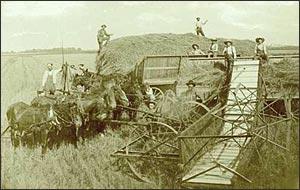
Differences in respect to rice in the West and East are reflected even in the rules of behavior at the table. Varieties of rice grains which stick together when cooked, Asians eat with their hands, picking rice in small lumps with your fingers and then sending it in his mouth. I also believe there are hands and sushi - rice delicacy of Japanese cuisine. Chopsticks Easterners eat white long grain rice.
In cases where the Asian reaching for sticks, taken as a European power plug - it is better to have a fork dishes crisp rice - long grain white and parboiled rice.
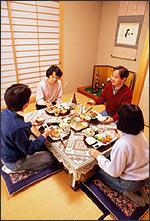
How to grow rice?
picture
Did you know that nearly half the world's population feeds almost exclusively on rice? Most of these people live in Asia.
Rice - the only major cereal that grows in water and is not afraid of flooding.
Rice is planted in a specially prepared seed slot. Then the seedlings transplanted on flat fields, surrounded by dykes, which are called checks.
Then the field flooded with water that passes through special gates in the walls surrounding each field. During the ripening rice rice farmers must maintain the water level is at least 13 centimeters.
To grow one kilogram of rice, it is necessary to spend 5,000 liters of water.
Water is drained for weeding and weed out the weeds by hand. Then, before the leaves will turn yellow from green, fields are drained again for harvesting. Rice cultivation requires a lot of labor.
Every year the world produces about 500 million tons of rice.
How does the processing of rice?
Cleaning: Remove foreign objects such as stones, wood chips, dry stalks, shells of snails;
Husking: Remove husks from the weight of paddy rice. This is done by means of ventilation;
Separation of raw: raw neotluschinny separated from rice grains (due to the difference in weight). Separated neotluschinny raw then again undergoes a process of husking.
Crushing: separation of bran from rice-grain stone cones or rollers. This process generally takes place in two or three stages depending on the desired freeness.
Sort by: Department of milled rice (a mixture of grains of different sizes: whole, broken and damaged seeds) using a sieve. Fig separated then sorted in packages in accordance with its classification.
Properties rice
Scientists have confirmed that rice, as well as other carbohydrates, can eliminate the lack of essential vitamins and minerals, caused by excessive use of semi-finished products, widely existing in the world today. In the rice starch is greater than in any other cereals, as well it contains a lot of vitamins of B (which reinforce the nervous system and have a beneficial effect on skin, hair and nails), as well as vitamins E and PP, and among minerals contained in rice are calcium, copper, iron, potassium, manganese, phosphorus, magnesium, zinc and selenium. And if that was not enough, in every 100 grams of uncooked rice is 4.1 grams of protein.
Potassium and sodium are contained in rice in a ratio of 5: 1 is sufficient to maintain the body in the acid-alkali balance. But this is true, if the rice used whole, without sanding and polishing all the more.
The average portion of rice (50 g) provides the human body required daily norm of protein and contains about 245 calories.
In ancient Greece, rice was considered a medicine: it is prescribed infirm, elderly and children
Those who seek to lose weight and lower cholesterol levels, it is necessary to include rice in their daily diet as rice contains only the constituent elements of fat, not the fat. As Figure thorough grinding does not contain fat, it does not overload the intestines, and is well absorbed.
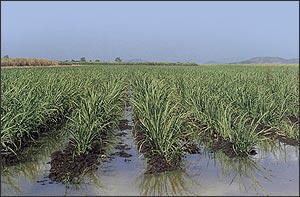
Rice varieties
Parboiled rice
This variety of rice is different with yellow light - the fact that the steaming it retains up to 80% of nutrients from the bran shell, which pass into the grain has become more durable. Cooked rice such longer (25 to 30 minutes), and during the cooking water gives yellowness, while becoming a snow-white and does not stick even after reheating. That's why parboiled rice is often used for cooking traditional pilaf.
Steaming - a special technology to increase the quality characteristics of rice. Paddy rice is soaked in water and then treated with hot steam under pressure. Past this procedure grain dried and polished as usual Fig.
After processing grain parboiled rice become amber hue and become translucent. Parboiled rice has the advantages: the steaming up to 80% of the vitamins and minerals contained in the bran envelope passes into a grain of rice, and the grains themselves become less brittle.
Yellowish tint disappears parboiled rice while cooking, and he becomes as pure white as white polished rice. However, parboiled rice cooking time is 20-25 minutes due to the fact that the grain after processing are becoming harder and slower than usual rice boiled soft. After cooking parboiled rice grains never adhered, moreover, it remains as it was delicious and crumbly even after reheating meals.
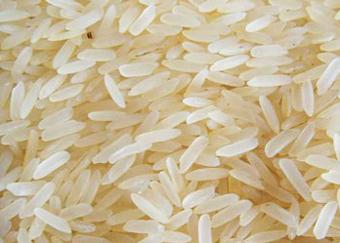
Long-
This is one of the most popular varieties of rice. Polished white grains. Preparing to absorb any way, or boiling.

Brown unpolished rice
Long-grain rice. Unpolished rice, peeled only from the outer inedible husk. It is called brown because grains of bran ostavlena shell because of which becomes brown rice. This is most useful rice, since most of the brown rice fiber, minerals and vitamins, as compared with white rice. In addition, it is more fragrant and has a slightly different texture. He needs more water by boiling, and he prepares longer white rice (about 40 minutes).
Jasmine rice
Long-grain rice. It is also called "Thai fragrant rice." It is similar to basmati, but slightly fragrant. Both of these lush rice and lightly cooked in a sticky form. He fragrant white rice. Serve with curry and oriental dishes.
Jasmine rice grows only in Thailand, a local variety.
Source:
The word "rice" is the basis of Indo-Iranian. Modern pronunciation comes from the Greek oryza, which has undergone modifications Latin oriza (riso).

The history of rice
Man grows rice for thousands of years and the grass is rightly called the most popular around the world. His homeland is considered the north of modern Thailand and Vietnam, this is where people first began to cultivate rice. This plant was delicious and gave a bountiful harvest compared with millet and wheat.
Around 2,500 years ago, the father of history, Herodotus wrote about rice, boldly claiming that people in India uses rice in food, as millet. A few centuries later, during the reign of Nero (1900 years ago), the other, already a Roman historian, Dioskuridus, mentioned the figure in its annals, describing it as a multi-purpose product. In particular, he carefully described all sorts of dishes that can be prepared from rice, as well as an important element for women's cosmetics and as a remedy for food poisoning.

If the descendants of the first farmers to cultivate modest rice fields in northern Thailand in 4000 BC, survived to the present day, they would have told the youth of today are highly instructive stories about the ancient empire, who built his fortune solely on the export of rice. By 500 BC the secret weapon of Thais has been disclosed, and began to cultivate rice in India, China, Indonesia and Malaysia.

Moving further north, rice changed: in South Asia rice demanded a lot of water and warm all year round, in central China, Korea and Japan have taken root varieties that are transferred and the cold night air, and a relatively small amount of water. In Korea and Japan grew particularly well round grain rice, adherent during cooking and at the foot of the Himalayas in the Indian province of Punjab and Pakistan - fragrant long "Basmati". From China to Japan, including India and Indonesia, rice - it's more than just products. It's part of the culture and civilization in these countries.

Vietnamese word «com» has two meanings: "cooked rice" and "food».
There is a legend, why the New Year in Vietnam cooked rice cakes and other rice dishes. Once upon a time there lived a king. He was old, and he knew that he left to live is not much. He had three sons, all of them were educated, strong and beautiful. King did not know whom to leave his successor, since all were worthy of it. Then he came up with such a thing.
New Year is approaching, and the king ordered his sons to make a treat for the whole country. The eldest son was able to prepare the dish only for the royal family, the middle - to the nation's capital. And the youngest son, realizing that only rice in the country is enough to feed all the people napek huge amount of rice cakes. Cakes enough for all, and the youngest son became heir to the King. Since then, Vietnam New Year always prepare rice cakes and other goodies from rice.
The Chinese word for agriculture in general, spelled and pronounced the same as the word for rice cultivation with the cultivation of seedlings, transplanting and its constant irrigation by flooding. The expression "break a bowl of rice" means to leave work.

In Japan, rice was brought settlers from the Korean Peninsula roughly in the III century BC. By this time, living on the territory of the Japanese archipelago population ate almost all stocks of game and began to slowly die out. And who knows what would have ended the story, if not the rice, which has improved the situation as nutrition and demography.
Soon this became the basis of cereal Japanese welfare state. They collect taxes, and they also paid a salary to officials. The richness of the princes and their authority determined by how much rice they received in their possessions. Collecting dues from the peasants this cereal, Japanese feudal lords sent it up for sale. The most famous rice market was in Osaka. In the XVIII and XIX centuries there annually sold more than four million bags of cereal. As prices on the Osaka Securities Exchange determines the cost of rice across the country, in Japan introduced a system of signal fires, located on the mountain tops. Depending on the wood smoke and herbal supplements get different colors. This was the designation of the price that give today for rice in Osaka.

It is difficult to overestimate the role of rice in Japanese culture. It is a symbol of the state and the soul of the nation. When the previous Emperor Hirohito feel it does not matter, he nevertheless felt obliged to ask the cereal harvest. And the current monarch every spring transplant rice seedlings on his imperial box, and it is considered an important event, which cover almost all the newspapers and television channels. And all because of centuries of Japanese people had a steady view of the world - if the rice spike, consequently, the rest all is well. That is why during the World War II Japanese soldiers in memory of the homeland handed boxes filled with this cereal with red plum in the middle.
And rice - is an integral part of religious ritual. For example, he is the main offering to the souls of the dead. In the transfer of authority from the family-in-law to daughter-in occurs only when it gives Shamoji - spatula for laying rice. One of the main deities worshiped by the Japanese who still is the spirit of the rice field Hatake but kamisama. In ancient times, during the rite of rice planting one of the girls buried alive, to propitiate the gods of rice fields. Over time, the rite was, fortunately, modified, but some of its elements have been preserved to this day. Girls, plant rice seedlings in the field, coated with mud person or hem of her dress. This want to emphasize their magical connection with the deities of rice fields. After this ceremony all its participants become "brides", "women" or "children" rice deities.
By the way, popular in the archipelago sumo wrestling is nothing but a ritual dedicated to this spirit. It was believed that the more tread on the ground, the higher the yield of rice it will.
There is a Japanese legend about a landowner who lived in the times of the ancient empire. One man had a great harvest. And he decided to have some fun with joy, made from rice cake and began to shoot her with a bow as a target. Rice cakes suddenly turned into a white bird and flew away. And this entertainer never appeared on the rice fields ...
Few people know that the name of Honda means "main rice field." Rather, in the western world rice brought Alexander the Great after the conquest of India in 350 g BC. It is believed that the rice was one of the products that are traded in the markets of spices in Alexandria, although it was significantly cheaper than pepper.
In Europe, the first to be treated as an exotic seasoning: afford a rice dish, brought from distant Asia, could only honorable gentleman. Rice used in the preparation of desserts and sweets for holiday treats.

However, after the plague epidemic in the thirteenth century, in Southern Europe desperately lacked the manpower and food for commoners. Cultivation of wheat was too time-consuming process for flagging thinned and people. Came to the aid rice, which sowed the fields of Sicily and Valencia. Rice has taken root in Italy and Spain, and was mostly round-srednezernym. He did not require large amounts of water for irrigation and bring a good harvest.
In 1300, the figure was first mentioned in the records of the Duke of Savoy in Piedmont (Northern Italy). In the XV century figure mentioned in a letter written to the Duke of Milan, and to the XVI century, Milan was surrounded by rice fields, glistening in the sun. Over the centuries, rice cultivation spread throughout Lombardy, Piedmont and Venice.
Over time, the rice became popular in Northern and Central Europe, where he was not allowed to grow climate, however, was possible exports from Asian and American colonies. English rice pudding came in cookbooks in the eighteenth century; traditional rice dishes appeared even in northern countries such as Finland and Norway. There are several theories about the origin of rice in the United States. In 1694, badly battered by storms Dutch ship anchored in the bay of Charleston in South Carolina. Local residents had the crew of the ship a warm welcome and helped with repairing the vessel. At the moment of parting the ship's captain expressed its appreciation to the residents of South Carolina, and presented it to the governor a few samples of his gruza- grain rice. Captain could hardly imagine then that this gift will be the starting point of the US rice industry, such as we know it today.
South Carolina was the first rice-producing state in the US. However, after the Civil War, rice cultivation has stopped in South Carolina and moved to the West: in Louisiana, Arkansas and Texas.
History of Australian rice is inextricably linked with the wave of Japanese immigration at the turn of the nineteenth and twentieth centuries. Farmers enthusiasts and government-backed entrepreneurs with varying success mastered the virgin lands and tried to get a good crop of rice.
The first bags of seed rice imported from Japan, contained a large proportion of semi-wild red rice and the harvest had almost completely destroyed. Only in the 70s of the twentieth century, Australia was able to call myself a country exporting high quality rice. Historically, the main type of rice grown in Australia - Round, but in recent decades breeders brought several varieties of long-grain rice, the demand for which has increased due to the influx of immigrants from Asia. The first crops of rice in the Russian empire appeared on the orders of Peter the Great, after the Persian campaign.
In Russian, the word "rice" appeared only in the end of XIX century, being derived from the English. "Rise" to the same figure called "Saracen grain" or "Saracen wheat", then the name was transformed into "sorochinskoe millet."
It in small quantities have been cultivated in Astrakhan, Rostov, Stavropol. In a large volume of rice began to grow in the Krasnodar Territory in times of power Nikita Khrushchev. Russian figure (kruglozernisty) - the northernmost rice in the world.

Differences in respect to rice in the West and East are reflected even in the rules of behavior at the table. Varieties of rice grains which stick together when cooked, Asians eat with their hands, picking rice in small lumps with your fingers and then sending it in his mouth. I also believe there are hands and sushi - rice delicacy of Japanese cuisine. Chopsticks Easterners eat white long grain rice.
In cases where the Asian reaching for sticks, taken as a European power plug - it is better to have a fork dishes crisp rice - long grain white and parboiled rice.

How to grow rice?
picture
Did you know that nearly half the world's population feeds almost exclusively on rice? Most of these people live in Asia.
Rice - the only major cereal that grows in water and is not afraid of flooding.
Rice is planted in a specially prepared seed slot. Then the seedlings transplanted on flat fields, surrounded by dykes, which are called checks.
Then the field flooded with water that passes through special gates in the walls surrounding each field. During the ripening rice rice farmers must maintain the water level is at least 13 centimeters.
To grow one kilogram of rice, it is necessary to spend 5,000 liters of water.
Water is drained for weeding and weed out the weeds by hand. Then, before the leaves will turn yellow from green, fields are drained again for harvesting. Rice cultivation requires a lot of labor.
Every year the world produces about 500 million tons of rice.
How does the processing of rice?
Cleaning: Remove foreign objects such as stones, wood chips, dry stalks, shells of snails;
Husking: Remove husks from the weight of paddy rice. This is done by means of ventilation;
Separation of raw: raw neotluschinny separated from rice grains (due to the difference in weight). Separated neotluschinny raw then again undergoes a process of husking.
Crushing: separation of bran from rice-grain stone cones or rollers. This process generally takes place in two or three stages depending on the desired freeness.
Sort by: Department of milled rice (a mixture of grains of different sizes: whole, broken and damaged seeds) using a sieve. Fig separated then sorted in packages in accordance with its classification.
Properties rice
Scientists have confirmed that rice, as well as other carbohydrates, can eliminate the lack of essential vitamins and minerals, caused by excessive use of semi-finished products, widely existing in the world today. In the rice starch is greater than in any other cereals, as well it contains a lot of vitamins of B (which reinforce the nervous system and have a beneficial effect on skin, hair and nails), as well as vitamins E and PP, and among minerals contained in rice are calcium, copper, iron, potassium, manganese, phosphorus, magnesium, zinc and selenium. And if that was not enough, in every 100 grams of uncooked rice is 4.1 grams of protein.
Potassium and sodium are contained in rice in a ratio of 5: 1 is sufficient to maintain the body in the acid-alkali balance. But this is true, if the rice used whole, without sanding and polishing all the more.
The average portion of rice (50 g) provides the human body required daily norm of protein and contains about 245 calories.
In ancient Greece, rice was considered a medicine: it is prescribed infirm, elderly and children
Those who seek to lose weight and lower cholesterol levels, it is necessary to include rice in their daily diet as rice contains only the constituent elements of fat, not the fat. As Figure thorough grinding does not contain fat, it does not overload the intestines, and is well absorbed.

Rice varieties
Parboiled rice
This variety of rice is different with yellow light - the fact that the steaming it retains up to 80% of nutrients from the bran shell, which pass into the grain has become more durable. Cooked rice such longer (25 to 30 minutes), and during the cooking water gives yellowness, while becoming a snow-white and does not stick even after reheating. That's why parboiled rice is often used for cooking traditional pilaf.
Steaming - a special technology to increase the quality characteristics of rice. Paddy rice is soaked in water and then treated with hot steam under pressure. Past this procedure grain dried and polished as usual Fig.
After processing grain parboiled rice become amber hue and become translucent. Parboiled rice has the advantages: the steaming up to 80% of the vitamins and minerals contained in the bran envelope passes into a grain of rice, and the grains themselves become less brittle.
Yellowish tint disappears parboiled rice while cooking, and he becomes as pure white as white polished rice. However, parboiled rice cooking time is 20-25 minutes due to the fact that the grain after processing are becoming harder and slower than usual rice boiled soft. After cooking parboiled rice grains never adhered, moreover, it remains as it was delicious and crumbly even after reheating meals.

Long-
This is one of the most popular varieties of rice. Polished white grains. Preparing to absorb any way, or boiling.

Brown unpolished rice
Long-grain rice. Unpolished rice, peeled only from the outer inedible husk. It is called brown because grains of bran ostavlena shell because of which becomes brown rice. This is most useful rice, since most of the brown rice fiber, minerals and vitamins, as compared with white rice. In addition, it is more fragrant and has a slightly different texture. He needs more water by boiling, and he prepares longer white rice (about 40 minutes).
Jasmine rice
Long-grain rice. It is also called "Thai fragrant rice." It is similar to basmati, but slightly fragrant. Both of these lush rice and lightly cooked in a sticky form. He fragrant white rice. Serve with curry and oriental dishes.
Jasmine rice grows only in Thailand, a local variety.
Source:



